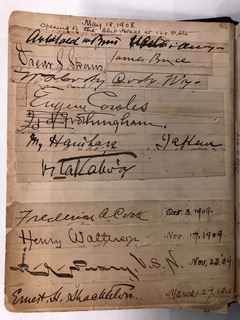Club served as forum for debate over first to reach North Pole
On Friday, Jan. 27, 2023, the National Press Club History and Heritage Committee hosted Gilbert M. Grosvenor to talk about his book A Man of the World: My Life at National Geographic. Gilbert M. Grosvenor was interviewed by his brother, Ed Grosvenor, a member of our committee.
In my brief introduction, I noted I had found the name of Gilbert and Ed’s grandfather, Gilbert H. Grosvenor, among the members listed in the Club’s 1914 yearbook, meaning Grosvenors had been part of the Club for about 110 years.
But during the talk, Gilbert Grosvenor referred to how National Geographic had sponsored Adm. Robert E. Peary’s quest to be the first person to reach the North Pole in 1909.
That made me remember a story in my recent book, Tales from the National Press Club, about how the first news events at the Club were the back-to-back visits of the two claimants to be the first to reach the Pole – Peary and Frederick A. Cook.

Cook came on Oct. 3, 1909, and Peary on Nov. 23. Both men climbed the stairs to the Club, then at the corner of 15th and F Streets, to meet with the members.
It stands to reason that Gilbert H. Grosvenor, as a sponsor of the North Pole expedition, would have worked to set up this event. That means he was a member of the Club in 1909, just a year after it was founded. And he organized the first news events at the Club that have numbered untold tens of thousands over the ensuing 114 years.
The signatures of both Cook and Peary appear in the opening pages of the Club’s autograph book.
Here are the basics of the story:
In September 1909, both Peary and Cook arrived back in the United States, each insisting he had reached the North Pole, the holy grail of early 20th century explorers. Cook claimed that he had reached the pole on April 28, 1908, but his grueling return trip took more than a year. Robert Peary claimed he reached the pole on April 6, 1909, and insisted Cook’s claim was bogus.
The New York Times championed Peary. Along with the Times, Peary was funded by the National Geographic Society. The New York Herald took up Cook’s cause. The public became intensely interested, with factions supporting each explorer and denigrating the other.
The Washington Star described Peary’s reception in the Club’s cramped quarters:
“The sitting room of the National Press Club was uncomfortably filled yesterday when Commander Robert E. Perry entered to shake hands with the biggest crowd of newspapermen he had ever seen. … The fire was glowing brightly, pipes, cigars and cigarettes were glowing and the crowd was thick. The explorer walked through a lane of writers and was introduce by President (William) Spurgeon.”
Which explorer reached the Pole first remained controversial right up until recent times.
Cook still has his own backers, but his claim seemed weak.
At one point the National Geographic Society debunked its own claim that Peary had reached the Pole. But then Gilbert M. Grosvenor launched new research using the daily soundings Peary made of the depth of the Arctic Ocean as he made his way to the Pole, he said.
Added to that was an analysis of the shadow cast by the flag pole put into the ice where Peary claimed discovery. Using data only recently available, National Geographic Society researchers were able to track Peary’s position using his soundings with the exact depth of the sea he was crossing over. That put him within 60 miles of the Pole when the continental shelf dropped off precipitously, Grosvenor said.
If you know the time and date and the length of the shadow of the sun from the flag pole, it is possible to determine the exact location of where the flag was placed, Grosvenor said. The National Geographic Society's analysis put it within five miles of the Pole.
“That’s good enough for government work,” Grosvenor quipped.
Journalist Lincoln Steffens wrote in 1909 that the battle was the story of the century (the century being only nine years old). “Whatever the truth is, the situation is as wonderful as the Pole. And whatever they found there, those explorers have left there a story as great as a continent.”
